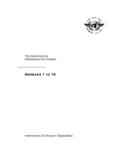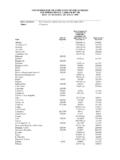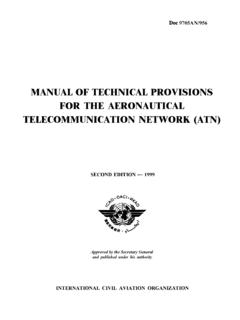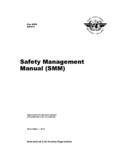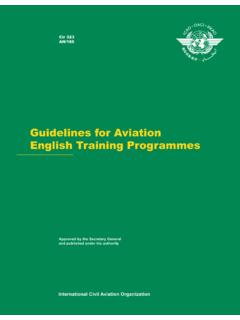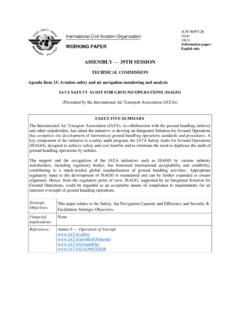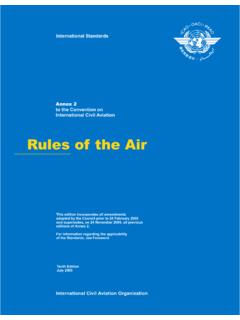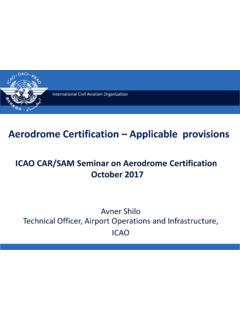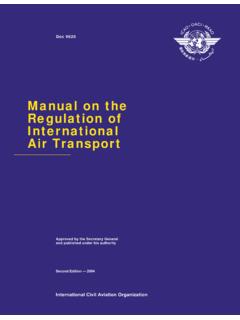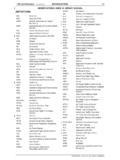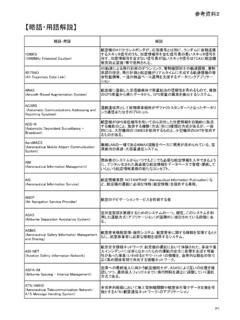Transcription of Multilateration (MLAT) Concept of use
1 Multilateration (MLAT) Concept of use Edition September 2007 INTERNATONAL CIVIL AVIATION ORGANIZATION ASIA AND PACIFIC OFFICE Multilateration (MLAT) Concept of Use Edition September 2007 Page 2 TABLE OF CONTENTS Table of List of Acronyms ..3 Glossary of Terms ..4 Chapter 1. Purpose and scope ..5 Concept overview ..6 Chapter 2. Concept for Surveillance Using Multilateration ..7 General ..7 MLAT functionality ..7 The role of MLAT in Air Traffic Management (ATM) ..8 ATM improvements and benefits ..9 MLAT applications ..9 Chapter 3. Operational Deployments.
2 11 Chapter 4. Chapter 5. Multilateration (MLAT) Concept of Use Edition September 2007 Page 3 List of Acronyms ADS-B ADS-C ADSP AIGD AIRSCENE AIS APANPIRG APW ASAS ASDE ASM ATC ATFM ATM ATMCP CAP CDTI CNS cpdlc DLIC ELT ETA FANS F&CM FIS-B FMS GNSS GPW HF HMI IAF ICAO IFR MDS MLAT MSAW MTCD OPLINKP PSR RPT SAR SARPs SASP SMC SSR STCA TCAS automatic dependent surveillance broadcast automatic dependent surveillance contract (also known as ADS or ADS-A) ADS Panel (of ICAO) ADS-B Implementation and Operations Guidance Document Trade name for Rannoch Multilateration aeronautical information services Asia-Pacific Air Navigation Planning and Implementation Regional Group area proximity warning airborne separation assistance system airport surface detection equipment airspace management air traffic control air traffic flow management air traffic management Air Traffic Management Operational Concept Panel controller access parameters cockpit display of traffic information communications.
3 Navigation and surveillance controller-pilot data link communications data link initiation capability emergency locator transmitter estimated time of arrival future air navigation systems flow and capacity management flight information service broadcast flight management system global navigation satellite system ground proximity warning high frequency human-machine interface initial approach fix International Civil Aviation Organization instrument flight rules Multistatic Dependent Surveillance: Sensis trade name for Multilateration Multilateration minimum safe altitude warning medium term conflict detection ICAO s Operational data Link Panel primary surveillance radar regular passenger transport search and rescue Standards and Recommended Practices ICAO s separation and airspace safety panel surface movement control secondary surveillance radar short term conflict alert Traffic alert and collision avoidance system traffic information service broadcast Multilateration (MLAT)
4 Concept of Use Edition September 2007 Page 4 TIS-B VFR VMC WAM visual flight rules visual meteorological conditions Wide Area Multilateration Foreword This document presents the Multilateration Surveillance (MLAT) Concept of use and therefore provides a description of MLAT systems and their detailed role as an application enabling important changes to the future communications, navigation, and surveillance/air traffic management (CNS/ATM) system. The description of the role of MLAT takes into account the heterogeneous and evolving situation with respect to the available ground infrastructure, aircraft capabilities, airspace regimes, the coincidence with Automatic Dependent Surveillance Broadcast (ADS-B) systems, and interface with legacy surveillance systems.
5 Wide Area Multilateration (WAM) implementations are an opportunity to provide useful ATC surveillance where it is required and concurrently introduce ADS-B for partial use. This forms a graduated transition from the current global environments to a future ADS-B based system. The MLAT Concept of use is described to show potential use in the wide area and airport surface operations, and that it is able to be considered both as an independent system and as complementary to other enablers such as secondary surveillance radar (SSR), SSR Mode S, ADS-B or ADS-C. The impacts on operational and organizational levels arising from the introduction of MLAT systems is noted for consideration.
6 Glossary of Terms In this document: ADS-B IN means the reception of ADS-B position reports by an aircraft. ADS-B OUT means the transmission of ADS-B position reports. Surveillance System means an airborne or ground system used for monitoring the positions of aircraft and other objects for the purpose of air traffic management. _____ Multilateration (MLAT) Concept of Use Edition September 2007 Page 5 Chapter 1. Introduction Purpose and scope The purpose of this document is to develop a Concept of use for MLAT. This technology is being developed, tested and is also used operationally in several areas of the world.
7 However, international standards to incorporate MLAT into the future global CNS/ATM system have not yet been completely developed. This document is a step in this ICAO process. The work to develop SARPs and guidance material for ADS-B was based upon a Concept of use for the technology, as agreed by the 11th Air Navigation Conference in 2003. Since that time a major conceptual change has occurred with the term radar now being replaced in many ICAO documents with the term ATS Surveillance System and an associated performance-based definition; a recognition that ADS-B and other technologies can provide radar-like services.
8 APANPIRG has chosen to follow a similar procedure to that successfully used for ADS-B; to develop a Concept of Use so observers and participants have a common understanding, and then to update the ADS-B Implementation and Operational Guidelines Document (AIGD) to include MLAT. The scope of this document is restricted to the Concept of use portion of the task. It does not contain specific operational requirements, although its contents will lead naturally to the development of operational practices for MLAT. Background In the early 1990 s, ICAO approved the Concept of the Future Air Navigation System (FANS) based on satellite and datalink technology, which later became known as CNS/ATM.
9 It was recognised that the traditional ATC surveillance system has limitations that constrained its capabilities in the existing and future ATM environment. The limitations identified include the following: limited or no conventional surveillance - including non-equipped continental areas, low altitudes, non-continental areas, surface movements, silence cones, blind areas, antenna screening, etc. In some cases ( oceanic areas), this will result in the need for procedural control, using voice position reports; electro-mechanical rotation of the classical radar antennas, not only with high power demand and RF output, but also inefficient scanning periods and limited ability to adapt the reporting rate to suit ATC needs.
10 (Note: E-SCAN antennas may offer an alternative in this case); radar garbling, fruit and splitting; unavailability of aircraft derived data , beyond the Mode A/C identification and altitude data ; non-homogeneous operation, caused by the current existence of a diversity of systems with different performance and capabilities; Multilateration (MLAT) Concept of Use Edition September 2007 Page 6 increasingly some regions have a shortage of Mode A codes (a maximum of 4096 available) requiring frequent changes of code during the flight or duplicate use which can create identification ambiguities; lack of capability to fully support future airborne situation awareness applications, because the corresponding surveillance data are not available to the aircrew; and lack of capability to fully support airport surface surveillance applications.
